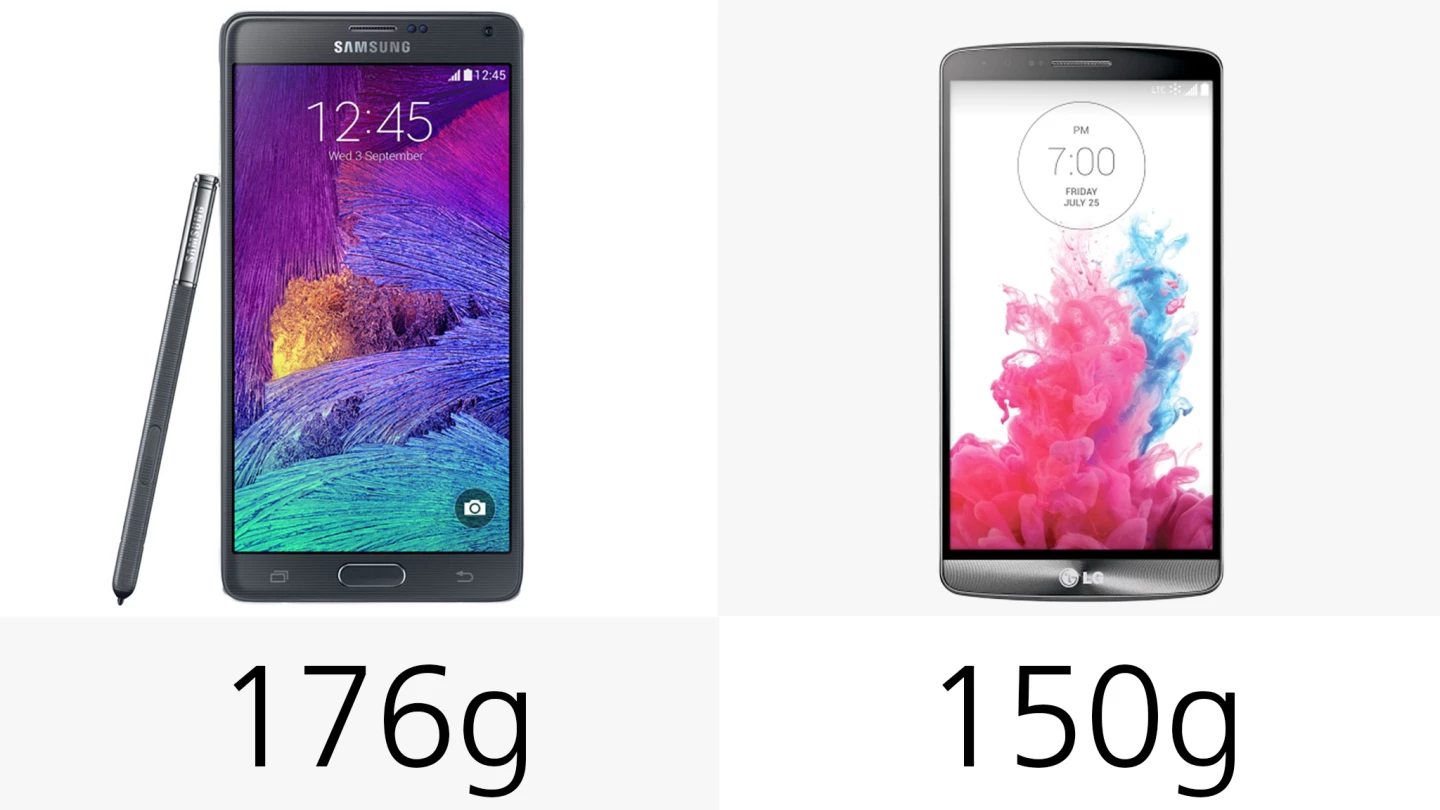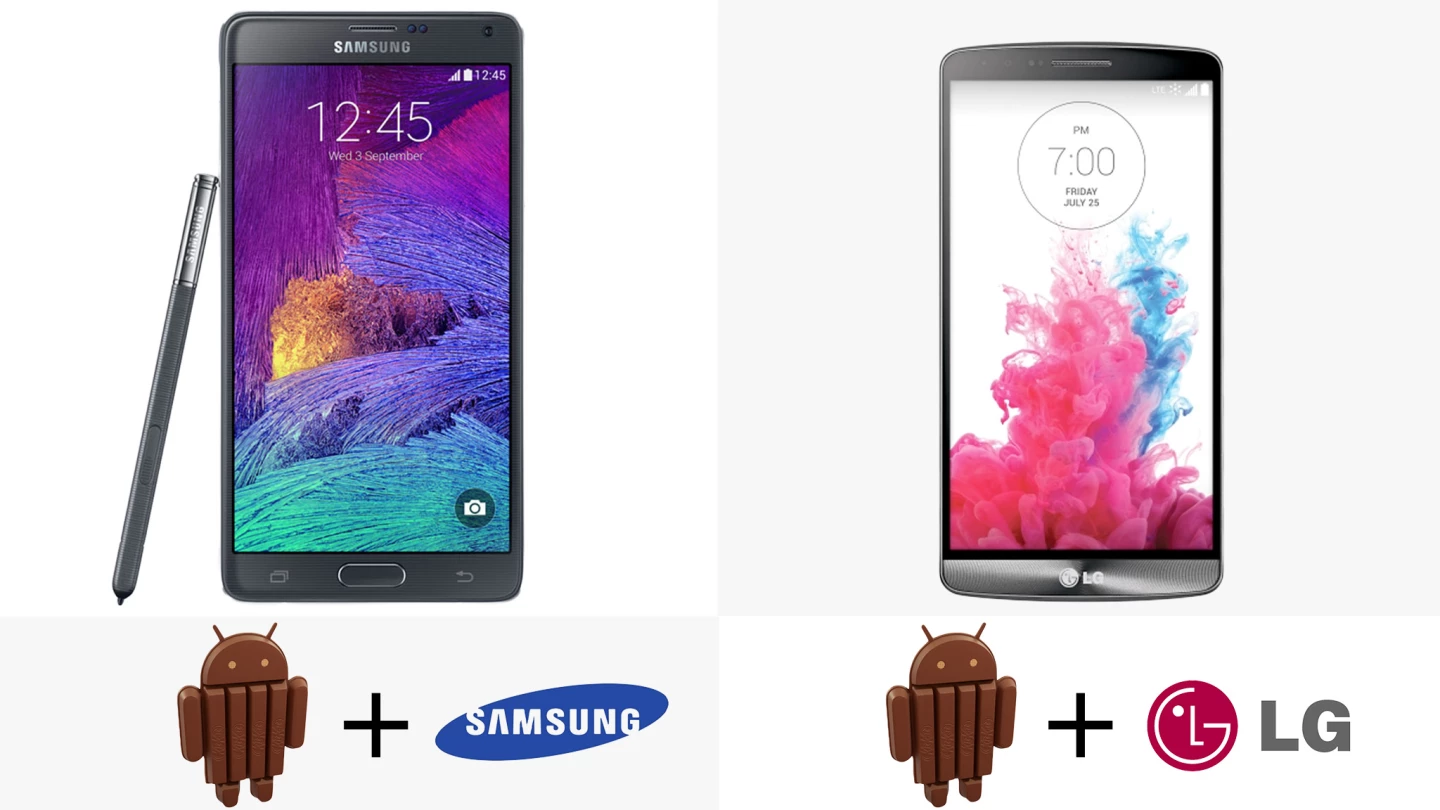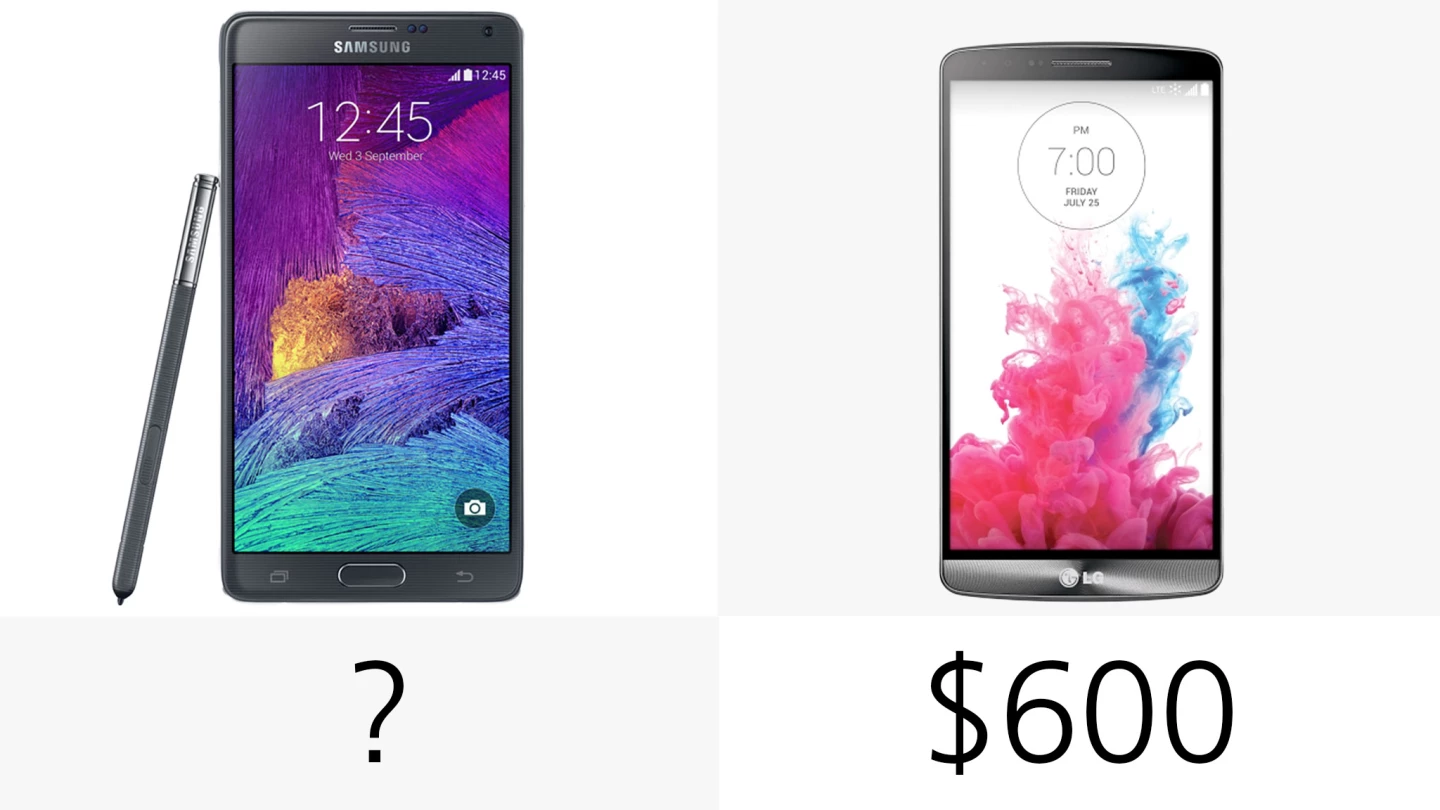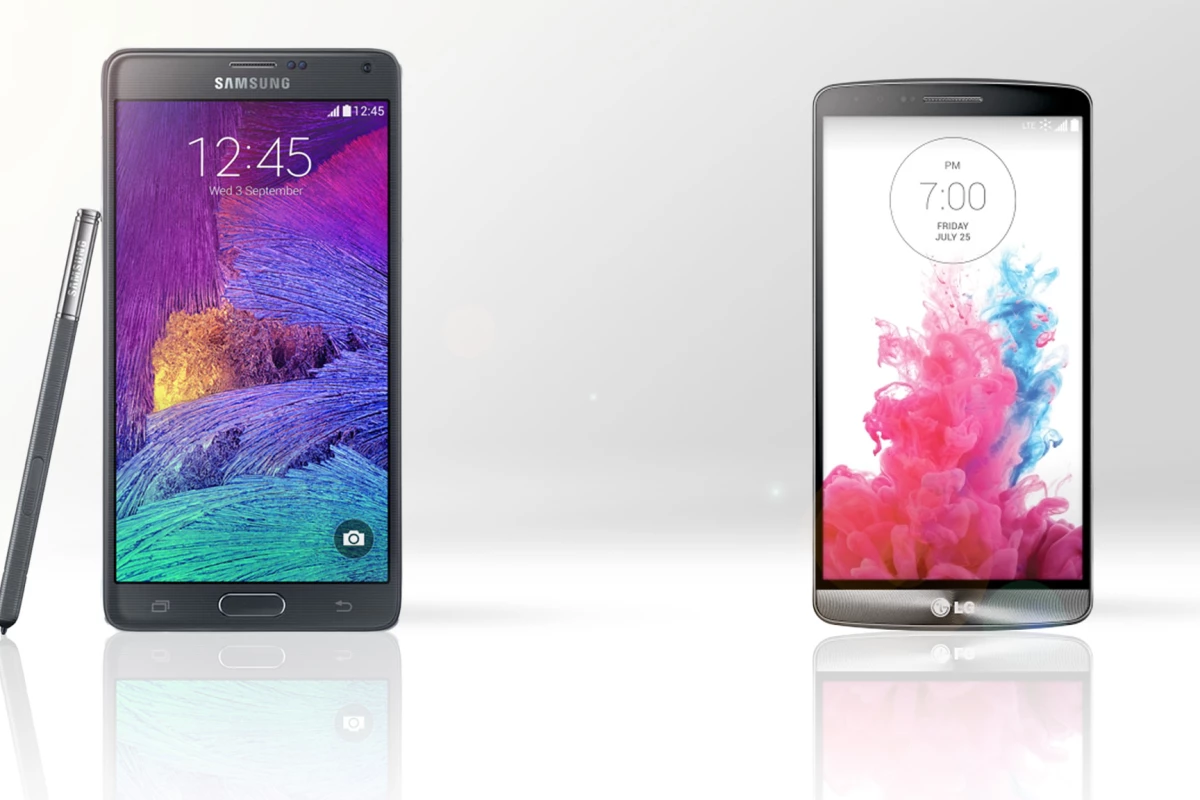Not long ago, Samsung's Galaxy Notes were pretty much the only phablets worth paying attention to. But with super-sized phones becoming more and more common, the Note series has more competition than ever. Let's see how Samsung's latest, the Galaxy Note 4, stacks up next to one of its biggest rivals, the LG G3.
Size

The Galaxy Note 4 lives up to its phablet moniker a bit more than the LG G3 does. Not only does the Note have a bigger screen, but it's about 5 percent longer and 5 percent wider.
Though the Note 4 is a bit thicker than last year's model, it is still 5 percent thinner than the G3.
Weight

That smaller size could make the G3 slide into your pocket a little easier, but it has also another advantage: it's 15 percent lighter.
Build

Nothing is what it seems ... at least in this category. The Galaxy Note 4 has a leathery finish (almost identical to what we saw on the Note 3), but it's still made of plastic. And that brushed metal look that you see on the G3? Yep, that's plastic too.
The exception is the metallic band that wraps around the edge of the Note 4. This time around, it's really made of metal.
Colors

We're looking at four color options for the Note 4, and five for the G3. For the G3, though, only black, white and gold options are currently available in the US.
Display (size)

The G3 gives you 93 percent as much screen real estate as the Galaxy Note 4.
Display (resolution)

One of the Note 4's biggest upgrades over the Note 3 is its leap to a Quad HD display. You could argue that the difference between 1080p and Quad HD amounts to overkill, but my eyes can usually appreciate the extra pixels.
Display (type)

The Galaxy Note 4 is the first Quad HD device that we've played with that uses Super AMOLED screen tech. It was hard to get a great read on the display's appearance in the hands-on area at Samsung's launch event, but AMOLED screens typically have richer colors and greater contrast.
Stylus

It wouldn't be a Galaxy Note without something to take notes with, would it? Samsung's S Pen is back for the latest model, with some improvements in tow. Though its design hasn't changed much, Samsung did double the pressure sensitivity in the new Note's stylus.
Tap-on display

The G3 brings back the same Knock-On feature that we first saw in the G2. It lets you turn on your display just by rapping twice on it.
Knock Code, also on the G3, takes the same concept and marries it to your phone's security. Just set a series of taps across a quadrant, and use that unique pattern to unlock your G3.
Fingerprint sensor

Like the Galaxy S5, the Note 4 has a (swipe-based) fingerprint sensor.
Heart rate monitor

The Galaxy Note 4 also borrowed the GS5's heart rate monitor, which sits on its backside.
Water resistance

The Note 4 doesn't, however, have a water resistance rating. I'm guessing that's because the S Pen's slot would require some sort of cover, making the phablet a lot less convenient to use.
Battery

We'll have to wait to see what battery life looks like in the Galaxy Note 4, but Samsung is saying that it will last longer than the Note 3 did.
When we tested the G3, it delivered solid enough battery life – but it also wasn't its killer feature.
Ultra Power Saving Mode

Samsung's Ultra Power Saving Mode lets you stay on the grid by severely limiting the phone's available processes (and turning the screen black & white) when you're almost out of juice. By temporarily turning your expensive phablet into a glorified feature phone, it can stretch just 10 percent remaining battery life into an extra 24 hours of uptime.
Fast charging

Samsung says that, as long as you're using the default Samsung charger, the Note 4 can jump from 0 to 50 percent battery life in "about 30 minutes."
Camera

The Note 4's camera wins on megapixels, but we'll need to put its camera through the paces before jumping to conclusions.
One thing I hope that Samsung improved on over its little brother is the camera's launch time. The Galaxy S5's shooter is conspicuously slow to launch.
Laser focus

The G3's laser-based autofocusing makes focusing and shooting quick and easy. Just tap the point on the screen where your subject is, and the G3 will (almost instantly) snap a shot with it in focus.
OIS

Both phones' cameras have Optical Image Stabilization onboard.
Infrared

Both phones include built-in IR blasters, so you can use your handset as a universal remote control for your TV or cable/satellite box.
Split-screen multitasking

Though each company uses a different marketing term, both devices have their own versions of side-by-side multitasking.
For the first time, with the Note 4 Samsung integrated its Multi-Window feature into the recent apps button. The company says it's also now easier to choose between single-window, multi-window and pop-up window modes.
One-handed mode

One of the biggest downsides of a huge screen is that it's tricky to use with one hand. Both of these devices offer their own ways of dealing with that.
One the Note 4, you can perform a quick gesture to shrink the entire screen down to a manageable size for one hand. On the G3, LG opted to just shrink the size of keyboards for its one-handed mode.
Virtual reality

Okay, so the Note 4 doesn't have any magic VR powers on its own, but it is the only phone that's compatible with Samsung's new Gear VR headset. If you buy the Oculus-powered accessory, you can slide the Note 4 in to provide the headset's display and processing power.
The G3 can play nicely with Google Cardboard, but it's technically a developer kit and not designed for consumer use.
Storage

We're looking at different storage tiers for each handset. They both have microSD slots, though, if the internal storage isn't enough for you.
Processor

Though the performance of most high-end mobile devices passed the point of concern long ago, the LG G3 had a noticeable amount of lag out-of-the-box. Switching to Android runtime pretty much took care of the problem, but, with a Quad HD display of its own, we'll be keeping an eye on this when we review the Galaxy Note 4.
You'll want to note that we're only showing the processor for the LTE version of the Note 4. For the HSPA/international variant, you'll get a Samsung Exynos octa-core processor in place of the Snapdragon.
RAM

If you buy the 32 GB version of the LG G3, then it will have the same 3 GB of RAM as the Note 4. If you opt for the 16 GB model, then you'll just have 2 GB.
Software

Both phones run Android 4.4 KitKat, with their respective manufacturer UIs layered on top.
Release

The G3 launched in Korea way back in May, but has only been available in the US since July. The Galaxy Note 4 will start shipping on October 17.
Starting price (off-contract)

We still don't know what the Note 4 will cost, but I'd guess we'll be looking at the same US$700 off-contract (usually $300 on-contract) price that the Note 3 originally rang up for.
For more on these two beasts, you can hit up our full reviews of the LG G3 and our Galaxy Note 4. We also got some hands-on time with the Note 4's curved-display sibling, the Galaxy Note Edge.
































